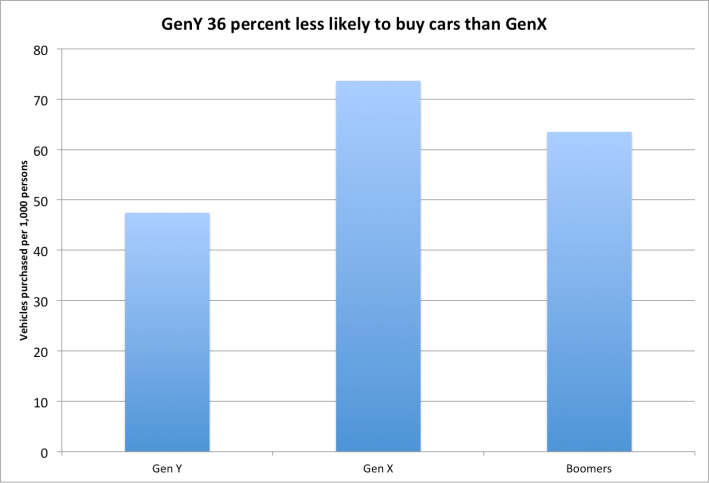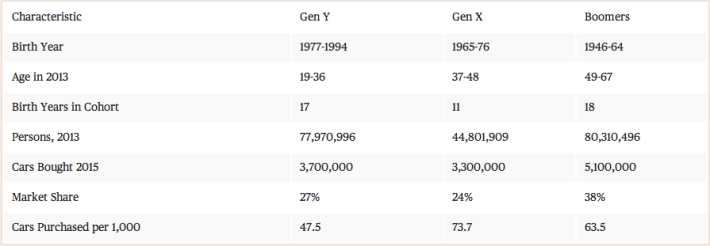
Cross-posted from City Observatory.
Will somebody teach the Atlantic and Bloomberg how to do long division?
Today, we take down more breathless contrarian reporting about how Millennials are just as suburban and car-obsessed as previous generations. Following several stories drawing questionable inferences from flawed migration data claiming that Millennials are disproportionately choosing the suburbs (they’re not) come two articles in quick succession from Bloomberg and the Atlantic, purporting to show the Millennials’ newfound love of automobiles.
Bloomberg wrote, “Millennials Embrace Cars, Defying Predictions of Sales Implosion.” Hot on its heels came a piece from Derek Thompson at the Atlantic (alternately titled “The Great Millennial Car Comeback” and “Millennials not so cheap after all”) recanting an earlier column that predicted Millennials would be less likely than previous generations to own cars.
The Atlantic and Bloomberg stories are both based on new estimates of auto sales produced by JD Power and Associates. The data for this report were not available on the JD Power website. However, JD Power released a press release making broadly similar claims last summer; we relied on that to better understand their methodology and definitions. (We’ll post a link to the new JD Power report as soon as it becomes available).
The headline finding is that Millennials (the so-called Gen Y) bought about 3.7 million cars, while their older Gen X peers bought only 3.3 million. (We extracted these numbers from the charts in the Atlantic story). Superficially, that seems to be evidence that Millennials are in fact buying more cars.
But there’s a huge problem with this interpretation: There are way, way more people in “Gen Y” than there are in “Gen X.” Part of the reason is that the Gen Y group -- also often called the “echo boom” -- were born in years when far more children were born in the U.S. The bigger, and less obvious problem is the arbitrary and varying periods used to define “generations.” According to the definitions used by JD Power, Gen Y includes people born from 1977 to 1994 (a 17-year cohort), while Gen X includes those born between 1965 and 1976 -- just an 11-year cohort. As a result, these definitions put nearly 78 million people in Gen Y and fewer than 45 million in GenX. There are fully 33 million more Gen Xers than Gen Y.* Hardly surprising, and not at all meaningful, that this much larger group buys about 10 percent more cars than the much smaller group.
This is where long division comes in. Let’s look at the rate of car buying on a per person basis for each of these two groups. By normalizing the data to account for the different number of people in each group, we get a much more accurate picture of the behavioral differences of individuals in each group – this is dead simple standard fare in statistical analysis. The 78 million Gen Yers bought about 3.7 million cars, or about 47.5 cars per 1,000 persons in the generation. Meanwhile, 45 million GenXers bought 3.3 million cars, or about 73.7 cars per 1,000. Rather than being just as likely or more likely than Gen X to buy cars, the typical member Gen Y is actually 36 percent less likely to buy a car than the previous generation.
Once you go to the trouble of normalizing the sales data to reflect the very different sizes of these “generations,” you get results that are pretty much exactly the opposite of what’s claimed in both the Bloomberg and Atlantic stories. Today, Millennials are buying new cars at a rate far lower than older generations. That’s consistent with other data we have showing Millennials being less likely to get drivers licenses, and when they do, driving fewer miles per year than previous generations.
To be fair, a really good answer to this question would require a bit more data sleuthing: Because automobile purchasing patterns vary over a person’s life cycle, you can’t accurately gauge the generational change in buying habits by comparing the current year buying habits of Millennials (average age: late 20s) with Gen X (average age: early 40s). The more interesting question to answer would be whether the average 25-year-old Millennial today is more or less likely to purchase a vehicle today than someone who was 25 in 2005, or in 1995 or in 1985. Unfortunately, we don’t have access to that data. However, if the folks at JD Power would be willing to dip into their considerable archives, we’d gladly do the computations.
No doubt this kind of story generates lots of clicks and tweets -- witness the Natural Resources Defense Council’s panicky “Uh-oh” retweet of this story. Clearly that is the coin of the realm in journalism these days, but it’s just plain irresponsible to make an utterly phony claim based on data that hasn’t been adjusted to reflect the size of different groups in question. As Paul Krugman said in a simpler time, “don’t be making claims that can be disproved with a copy of the statistical abstract and a pocket calculator.” There’s even less excuse for this today.
A couple of technical notes: Our estimates of population by birth year are from the Census Bureau: Annual Estimates of the Resident Population by Sex, Single Year of Age, Race, and Hispanic Origin for the United States: April 1, 2010 to July 1, 2013. The exact numbers of cars purchased by each generation were not reported in either the Atlantic or Bloomberg articles, so we estimated the numbers to the nearest 100,000 based on the chart published by the Atlantic; our estimates square with the values for market share reported in the article (the table omits data for sales to “pre-boomers” which make up approximately 10 percent of car sales, and explains why the total market share doesn’t add to 100%). We use the terms “Gen Y” and “millennials“ interchangeably in this post.
_____________
* – Towards the end of his article, Derek Thompson acknowledges the big discrepancy in the sizes of Gen X and Gen Y, allowing that there are “15 to 20 million” more Millennials than Gen Xers. Not only is the actual difference about 33 million, it begs the question of whether why Thompson didn’t find the time to do the very basic long division normalization that would have given a much more reasonable, and much different answer to the question posed by his article.






